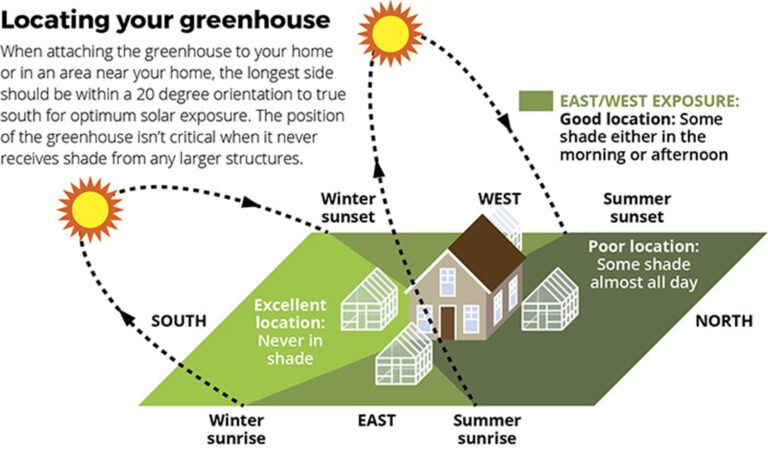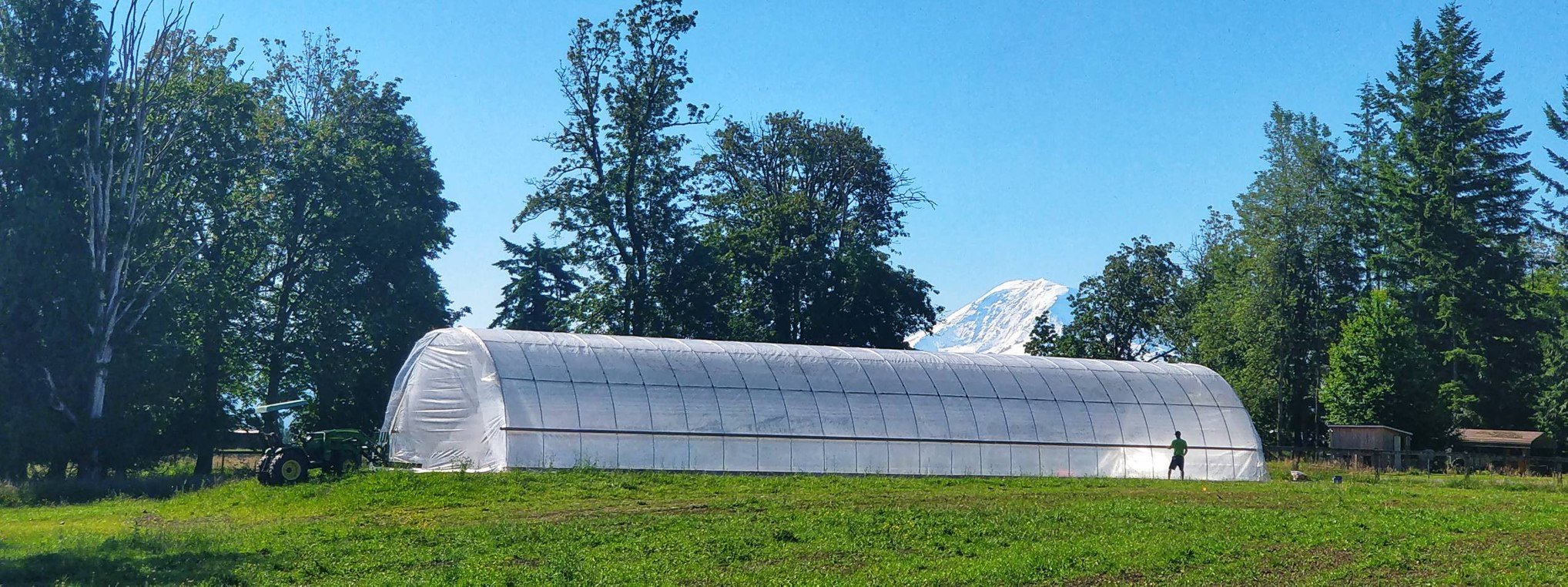Call us at 725-239-9966!
M-F: 8 AM-7 PM PST
Call us at 725-239-9966!
M-F: 8 AM-7 PM PST

When it comes to your greenhouse, location is everything. Choosing the optimal spot on your property can directly affect the growth, productivity, and health of the plants inside.
It's worth taking the time to carefully consider your options and weigh all the factors involved. A less-than-ideal site can leave your greenhouse shaded, your plants leggy and undersized, and result in continual hassles over the long term.
This comprehensive guide will walk you through all the key considerations for choosing the best site for your greenhouse. Whether you're a seasoned pro or new to greenhouse growing, following these positioning tips will help you maximize your greenhouse's performance.
Position your greenhouse with the longest side facing true south to maximize sunlight exposure throughout the day as the sun travels east to west.
Leave at least 25 feet of clearance around the greenhouse, especially on the north side, to prevent shading from trees and obstructions.
Observe the sun's path across your property throughout the seasons to find the spot with the most direct sunlight for the longest period.
Account for wind patterns and site the greenhouse in a sheltered spot, avoiding excessively windy areas.
Consider convenience factors too like proximity to your home, utilities, and accessibility for repairs and maintenance down the line.

The ideal location for a greenhouse is one that receives full, unobstructed sunlight, especially from the south. South-facing orientations are best as they provide the most exposure throughout the day as the sun travels east to west.
Avoid positions near trees, buildings, or other obstructions that can cast shadows or block the sun. Prioritize spots that get at least 6 hours of direct sun daily.
Now that we know what is the best location, let's see how we can position the greenhouse to increase the sunlight.
Sunlight is arguably the most critical element for your greenhouse. Just like outdoor garden beds, the plants inside rely on ample sunshine for robust growth.
Ideally, the greenhouse should receive at least six hours of direct sun daily. Unobstructed exposure is best, especially if you plan to grow veggies and fruits long-term. Here are things to look for when positioning your greenhouse:
The best location is south-facing to maximize sunlight exposure. In the northern hemisphere, orienting the greenhouse with its longest sides facing true south is ideal.
South-facing gives the most sunlight throughout the day as the sun rises in the east and sets in the west. For lean-to greenhouses, the optimal positioning is with the supporting wall on the north side and the sloped roof facing south.
Take time to observe the sun across seasons to understand its arc throughout the day. Use an annual sun path chart for your latitude to help visualize.
Plan the greenhouse's placement to capitalize on the sun's movement. Avoid spots that will fall into the shade for large portions of the day.
A south-by-southeast orientation is the next best option if true south isn’t feasible. Just make sure the structure doesn't line up perfectly east to west or it won't receive sunshine on the ends.
When surveying your property, avoid areas near structures, trees, or bushes that can cast shade on your greenhouse. Even partial shading can mean less vigorous, productive plants.
Deciduous trees are especially problematic. Avoid placing too close since they leaf out and shade the greenhouse during the growing season, then drop leaves and allow cold winter winds through.
Leave enough space around your greenhouse site to account for future tree growth. A 25-foot clearance north to south is recommended for full sun exposure.
Here's how much distance you have to keep based on the obstruction type:
| Obstruction Type | Recommended Distance |
|---|---|
| Deciduous trees | 25+ feet |
| Evergreen trees | 15+ feet |
| Buildings | 10+ feet |
| Fences | 5+ feet |
Notice where sunlight first strikes your property in the morning and how late it lingers in the evenings. East-facing spots see morning sun but have more shade in afternoons as the sun sets in the west.
The opposite is true for west-facing sites - they miss the early morning sun but receive more late daylight. South is ideal for getting the most equal amount of sun throughout the day.
Particularly for freestanding greenhouses, make note of wind patterns across your site. Avoid excessively windy areas that could cause damage, especially if you're in a hurricane-prone region.
Areas behind a windbreak like a wall or solid fencing can provide needed shelter. Leeward sides of hills and slopes are also less windy.

Beyond sun exposure, there are a few other important factors that determine the best spot for your greenhouse. Keep these in mind when deciding on placement:
It’s worth planning ahead and leaving room around your greenhouse if you think you may want to expand it later on. Having space to enlarge the structure or add additional greenhouses can be beneficial.
Leave at least 1 meter of space around a small greenhouse to start. For larger ones, allow enough room for you to access all sides for ventilation and maintenance.
You'll want easy access to electricity and water for your greenhouse. Situating it close to your home makes connecting utilities simpler, or at least within reach of an outdoor outlet and spigot.
Think about how you'll get power and water to your greenhouse if you start from scratch. Connecting to existing lines is easiest, but you can also use extension cords and hoses.
For regular use and upkeep, the greenhouse shouldn’t be too far from your home. But also consider visual appeal and allow distance from the house for aesthetic purposes, if desired.
Building closer to the house provides convenience for tending to plants daily. Just watch that it doesn’t shade the home or crowd other structures.
Also, weigh accessibility for getting supplies in and out. Leave room for paths wide enough for wheelbarrows or carts.
Colder pockets of your property can spell trouble for the greenhouse. Frost pockets at the base of slopes can be several degrees colder on frosty nights.
Positioning your greenhouse above cold air pools improves cold hardiness. Areas with good air drainage and circulation are less prone to frost.
You can also site the greenhouse closer to the home where radiant heat from the building helps shelter tender plants. Lean-to designs benefit from the insulating effects of an attached wall.
When deciding on your greenhouse location, consider ease of access for eventual repairs and replacement of broken glass panes or coverings.
Allow room to work around all sides. Situating it near sheds or other structures can make repairs difficult. Building against a wall also limits access.
Consider what you plan to grow and your general greenhouse needs when picking the site. For example, freestanding greenhouses ventilate better for temperature regulation.
Lean-to-styles are ideal for increasing a structure's solar gain. The attached models are perfect for propagating plants and sheltering potted specimens needing winter protection.
If you are planning to buy a greenhouse kit, be sure to check the dimensions and site requirements before finalizing the location. Our guide on the best greenhouse kits provides helpful tips on choosing the right kit for your needs and property.
Match the greenhouse design and footprint to your property’s sun patterns, wind exposure, and space constraints or allowances.

We hope this guide has made the site selection process clearer and provided you with the insights needed to choose the optimal location for your greenhouse.
Positioning your structure in the best spot for ample sun, convenience, and protection will set you up for greenhouse gardening success for years to come.
Now that you know what to look for in your ideal site, it's time to map out the possibilities on your property. We wish you the best as you plot out potential placement options and make this important decision.
Happy greenhouse growing! Let the sun shine in.
When selecting the best location for your greenhouse, it's crucial to account for several factors. Ensure it's close to a water tap for easy irrigation, situated at the base of a slope for proper drainage, and align the ridge of the structure east-west to maximize sunlight exposure. Additionally, consider proximity to utilities and level the area for stability.
To maximize light, avoid tall trees or structures that could obstruct sunlight. Additionally, choose a location where the greenhouse can also receive the first morning light and the last light in the evening. This ensures plants inside receive an equal amount of light for healthy growth.
Yes, placing your greenhouse on raised beds or near wooden structures can be beneficial. This can help in leveling the area and provide a stable base. However, it's important to ensure that the base is sturdy and level to support the greenhouse properly.
Yes, it's best to choose an area with good soil quality around the greenhouse. This ensures that the plants inside the greenhouse have access to the nutrients they need for healthy growth. Additionally, consider the drainage properties of the soil to prevent waterlogging.
If there's only one viable site available and it happens to be away from trees, that's perfectly fine. While trees can provide shade, it's more important to prioritize the maximum amount of sunlight. With proper positioning and care, your greenhouse can thrive without the need for nearby trees.

{"one"=>"Select 2 or 3 items to compare", "other"=>"{{ count }} of 3 items selected"}
Comments
Leave a comment